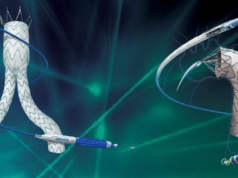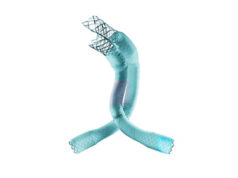
This article is an advertorial sponsored by Lombard Medical.
One of the novel applications of the Altura Endograft System is use in the revision of previously placed endovascular grafts or previous abdominal aortic surgery. Jörg Tessarek (Bonifatius Hospital Lingen, Lingen, Germany) has performed a number of such cases, and will be presenting data on his series at the Leipzig Interventional Course (LINC; 28–31 January, Leipzig, Germany). Here, Tessarek discusses the benefits of Altura in this type of revision surgery, details a notable case, and finally considers how this novel application of Altura might be of interest to the wider vascular community.
What are the main challenges of relining aneurysms that have been treated with other devices or by open repair in the past, and which are now failing?
The challenges for relining are located at different levels: coming from below, navigating through the existing device can be difficult, especially in narrow and tortuous anatomies. Maximum overlap of graft components is mandatory really, to achieve reliable fixation of the distal component to prevent further migration. Cannulation of fenestrations or target vessels, which can sometimes be covered by suprarenal fixation bare stents adds further time to the procedure and increases radiation dose, and as such, can put the patient at risks of complication.
In my opinion, Altura changes the game. The device has a low-profile flexible introducer, which enables exact and fast placement. The device relines and excludes the whole aneurysm and the failing endograft, not only parts of it. As a result, the migration forces are no longer applied to already migrating components. Telescoping of the main body and limb over the same wire makes extensive fluoroscopy use unnecessary.

Which types of devices have you relined with Altura?
To date, we have relined single tube, double tube and bifurcated grafts successfully. All of these grafts had bare stents for suprarenal fixation and contraindications for fenestrated cuffs and anchors. In one case an iatrogenic infrarenal dissection after aorto-iliac stent placement with rapid growth of the false lumen and intramural hematoma was treated successfully using the Altura device. The residual stent lumen was 4.5mm, which required robust post-dilatation of the endograft.
Have you used Altura to reline surgical grafts?
Not as yet, but with the low profile introducer and the device characteristics, I anticipate that there is likely to be real benefit to this treatment option, particularly in cases where there is evidence of aneurysm expansion, or anastomotic compromise at either end of the grafts.
What do you see as the benefits of using Altura for relining in these cases?
The characteristics of the Altura device enable its use as a complete substitute for failing grafts, or as a reliable repair component for procedural failure at the distal end. By placing the D-shaped graft components inside the lumen with sufficient overlap, this mimics a standard bifurcated graft. Additionally, the unique deployment technique of the limb allows an exact placement at the level of the hypogastric artery, thereby achieving a maximum distal landing zone.
Are there any particularly notable cases that you can share with us?
The most challenging case so far was an Altura relining of a type Ib endoleak after initial placement of a 100mm tube graft and coiling of a distal endoleak. The graft migrated sideward with the distal end sitting perpendicular to the aortic wall, and coils lying distal to the fabric edge. After cannulation over two 90° angulations and stiff wire placement, the graft could be slowly moved into the middle of the sack. The two Altura main body components were advanced under local anaesthesia in a routine manner with ballerina position and long overlap, resulting in a complete sealing without any migration of the coils.
How might this novel application of Altura be of interest to the wider vascular community?
The concept of siting a complete independent new endograft inside a failing graft without the need for complex manipulation at renal or visceral target vessel level might be a game changer. Given an appropriate infrarenal landing zone, deployment of the graft components can be successfully achieved inside any bifurcated graft, independent from its main body length. Graft overlap is not an issue here because the Altura device excludes the aneurysm and the failing graft by covering the whole diseased or failing segment.
As this is a novel use of Altura, can we expect any data on it in the near future?
Altura is being used for relining in several centres around Europe and I am aware that some encouraging outcomes are being reported anecdotally. Hopefully, we can collect data from all over Europe to look at this further; colleagues with known experience in this challenging field have already been contacted.













